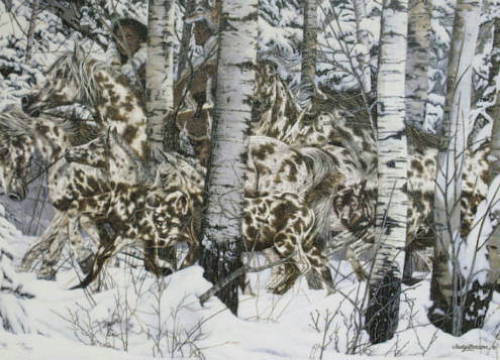
The Ghost Dance
The Ghost Dance was an attempt of a group of North American Indian tribes to further separate themselves from the white man and the religious doctrines they were forcing upon the tribal peoples. Among the Sioux and Arapaho, the Ghost Dance was one of the central rituals of a new religious movement that focused on the restoration of the past, as opposed to a salvation in a new future. The movement was active within limited tribes and mirrored other attempts by previous Indians to escape the civilization of the white man. The earlier movements included the Good Message of the Iroquois and the Dreamers of the Columbia River tribes. All of these movements had similar features including a rejection of the white man’s civilization, especially alcohol, weapons and technology. In addition, the movements preached unity among tribes, even those that were once enemies and a revival of Indian customs that were threatened by the civilization of European peoples.
The despair and nostalgia associated with the Ghost Dance reflects that period from which the movement evolved. Plains tribes faced losing their freedom and being overtaken of their homes, their beliefs and their existence. The Ghost Dance was a resurrection of the dead, a bringing back of the customs and way of life that the Indians were trying to hold onto.
The prophet who began the movement of the Ghost Dance was Wovoka, a member of the Piute Tribe. He was descended of a family of prophets and Shamans. Known as a medicine man, it was said that during an eclipse of the sun and while suffering from a high fever, he had a vision which inspired the development of the movement known as the Ghost Dance. The vision embodied the beliefs that inspired the followers of the movement including that the white man would disappear from the Earth after a natural catastrophe and that the Indian dead would return bringing with them the old way of life that would then last forever.
To bring these and the other beliefs into effect, the Indians had to practice the customs of the Ghost Dance movement and to renounce alcohol and farming and end mourning, since the resurrection would be coming soon. The most important practice to ensure the effectiveness of the movement was the dance itself.
The dance was unlike other Indian dances with fast steps and loud drumming. The Ghost Dance consisted of slow shuffling movements following the course of the sun. It would be performed for four or five days and was accompanied by singing and chanting, but no drumming or other musical instruments. In addition, both men and women participated in the dance, unlike others in which men were the main dancers, singers and musicians.
The first dance was held by Wovoka around 1889. Word spread quickly and the Ghost Dance was accepted by the Utes, Bannocks and Shoshone tribes. Eventually, the Plains tribes also adopted the Ghost Dance movement and the peaceful message of hope was spreading and uplifting many Indians. While adapting the movement, many tribes added specific customs and rituals to the Dance that reflected their tribes individuality. The Sioux added two specific elements including the use of hypnosis to bring about trances and aid in the communication with the dead, and a ghost shirt. Made of buckskin or cloth, the shirt was said to make the wearer immune to bullets, a weapon of death known initially only to the white man.
A famous Sioux warrior, Sitting Bull, adopted the Ghost Dance into his way of life. He was a respected leader, medicine man and warrior. His following of this movement alarmed the military and Indian Agencies. In 1890, just a few months after presiding at his first Ghost Dance, Sitting Bull was killed. His followers fled and joined the band of Kicking Bear, one of the first to practice with Wovoka. Donning their ghost shirts and with their beliefs firm in their hearts, the followers of the Ghost Dance were rounded up at Wounded Knee creek and killed while resisting arrest. Among those killed were women and children wearing their ghost shirts, which did not stop the bullets of the Indian Agencies or the Military.
The Ghost Dance continued to be danced in more southern tribes, but the end of the movement really came with the deaths at Wounded Knee. The hopes of the Indians also ended at that massacre. Many of Wovoka’s ideas and concepts were adopted by Peyote cults and can even be found in practice today. Indian tribes did not survive the push of the white man. Broken up and with broken dreams, the tribes were shuffled onto reservations and lost many of their customs and rituals. The Ghost Dance was one of those customs lost, but never forgotten. Resurrected from the past, the Ghost Dance and other tribal beliefs are brought to life everyday in the education of our nation.....Today, we still have the Ghost Dance, for this is where great things are revealed to us